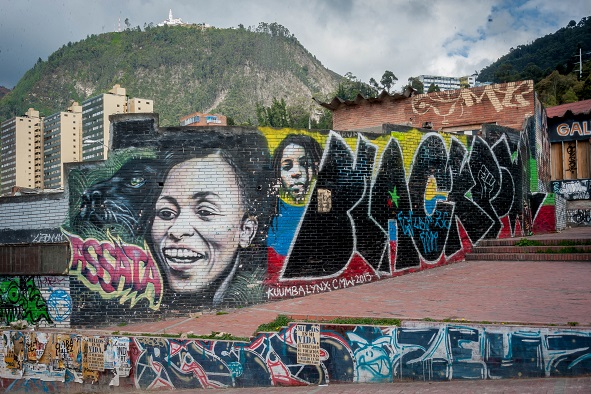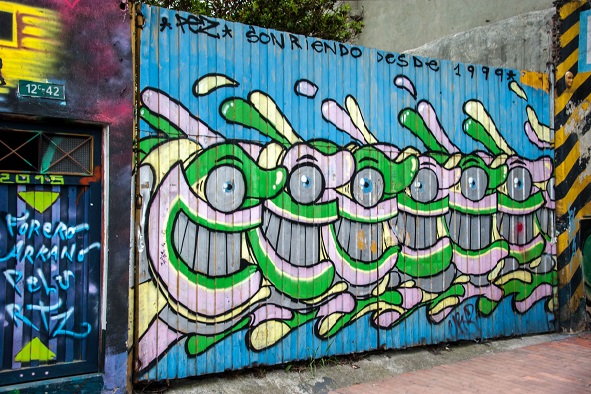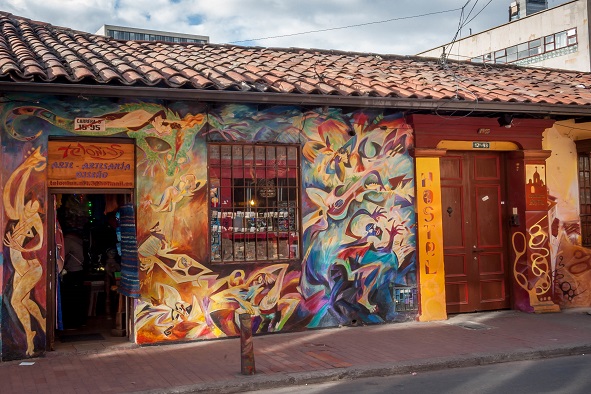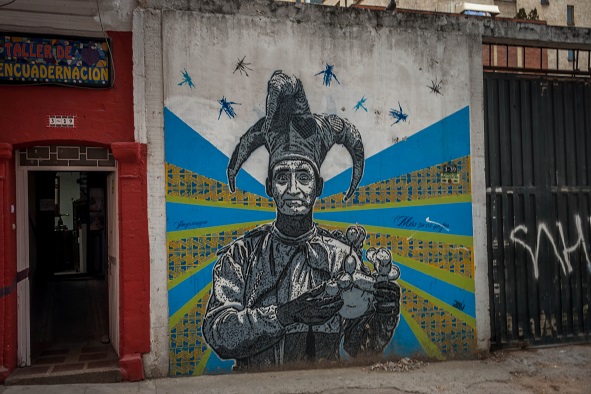Bogotá bursts with diverse cuisine, edgy street entertainment and cool-but-friendly people. To understand what makes Colombia’s high-altitude capital tick, head to its birthplace and explore its recently-rejuvenated urban art scene.

Bogota’s brilliant street art with Monserrate Mountain in the background (Photo: Simon Willis)
I’ll never look at Bogotá, or indeed any other city, the same way again.
Standing in the middle of the road, Jay, our guide, holds a hand up to the parping cars. The 25 of us camera-clutching tourists scamper across as he holds up the traffic. We lean against the flaking stone wall and gawp at a bird opposite that stretches the entire length of a white-washed Spanish colonial building’s façade.
“This is one of Guache’s pieces,” Jay shouts, as a bus chugs by.
He points to the bird’s long tail, rounded and painted in psychedelic colours. “Can you see a few white brush strokes over the end? The council began painting over the piece, saying it was illegal.
“Well, the community came out in protest and stopped the council. As you can see, the piece still stands today.”
Such revolts typify the city’s urban art scene and demonstrate the community’s strong affinity to its artists.
When I first visited Bogotá in 2012, I was struck by its size: Andean mountain peaks towering behind thousands of orange high-rises; three and four lane roads interweaving in all directions; and, of course, its eight million residents. Although I liked Colombia’s 2,640 meter-high capital, I didn’t know why.
To understand a city, I usually explore museums, join a walking tour or chat with locals, ideally over several frosty beers. Today, I’m breaking routine. I’m on the free Bogotá Graffiti Tour, exploring street art in the city’s oldest neighbourhood, La Candelaria.
Sprawling below the tree-covered Monserrate Mountain, La Candelaria is a maze of cobblestone walkways, undulating like a rollercoaster with museums, galleries, churches, pizza parlours and artisanal shops all along for the ride.
Leading our group is well-built Jahir Mauricio Dimate Burgos, also known as Jay – born in Bogotá, raised in New York.
“You know, this city is in the world’s top 10 for street art,” Jay says, clutching a bottle of water. Though I have little knowledge of the world’s other leading urban art scenes, I copy the knowledgeable crowd as they nod along to Jay’s claim. One guy from Denmark compares its quality to São Paulo in Brazil. “Oh yes,” I agree, not wanting to reveal my graffiti arm-bands.
“As well as locals,” Jay says, “some of the best international artists come and work here.”

El Pez’s Happy Style is known around the world (Photo: Simon Willis)
We stop at a row of cartoon fish covering a parking lot gate. The pink, green and yellow animals sport huge grins, typical of El Pez’s ‘Happy Style’ of art. The Barcelona-born artist’s worldwide reputation is such that these images have increased the value of this metal corrugated gate to $10,000.
Estate owners often welcome well-reputed artists like El Pez to scrawl on their walls, some even commission them to do so.
Reflecting the mood of a country
And it’s not just a property value increase that artists bring to La Candelaria. Dj Lu’s pineapple grenades and soldiers shooting love hearts display a clear anti-war message to the Colombian government and left-wing rebel group FARC, who are still entangled in a 50-odd-year-old armed conflict. Australian-born Crisp, street artist and founder of Bogotá’s Graffiti Tour, opts for a more subtle way of conveying his concern for inequality and corruption. His use of stencils, stickers and sculpture contribute further aesthetical dimensions to the street art scene.
Other works portray the struggles facing Colombia’s lower class and indigenous groups while some depict the city’s love for the circus. By the end of the two-hour tour, our desire to uncover hidden social and political messages leads us to scour every archway, doorframe and stone surface like archaeologists at a dig.

Bogotá’s Graffiti tour explores La Candelaria where most of the city’s street art appears (Photo: Simon Willis)
Graffiti has had anything but a smooth ride in Bogotá.
“A few years ago, artists used to be in real danger while working here,” Jay says.
Local authorities took a no-nonsense view of graffiti, forcing artists to operate under the cover of darkness. And even that proved unsafe. In 2011, a 16-year old boy was shot and killed by police after he was caught spraying an underpass. The officers involved attempted to absolve themselves of blame, falsely accusing the boy of robbing a bus.
The incident sparked a city protest, “a revolution,” declared Jay, and a demand for the police to be brought to justice. They were, and today street art is no longer seen as a crime, leaving artists free to work in broad daylight.
Contrasting cultures
After finishing the tour, I say adiós to the group and explore La Candelaria’s culinary scene.
I pass foreigners, distinguishable by their shorts and sandals (Bogotá often drops to 16 Celsius), shovelling in slices of pizza. Better instead to find the doughy arepas (cornbread) that sizzle and bubble on hot plates in many open shops; vendors flipping them to reveal a brown-tinged crust. In one restaurant, a cow’s leg rotates around a roaring fire, scorching the meat to a shimmering claret.
I head to Café Camino and devour four soft, freshly baked empanadas and a tinto (black coffee). For dessert, an oblea. Biting into its circular wafer crust, I shatter pieces into my beard while violet blackberry jam shoots out the side and splatters on the floor. Delicious, if a little messy.

The circus has long been associated with La Candelaria (Photo: Simon Willis)
Diversity doesn’t end with gastronomy in La Candelaria.
At Manzana Cultural (Culture Block), Fernando Botero’s museum displays his famous voluptuous and disproportioned paintings of typical Colombian life. Opposite, the name of the master of Magic Realism, Gabriel Garcia Marquez, adorns the Cultural Centre. A library fills one section while a gallery, auditorium, record store, two classrooms and the iconic maroon canopy of Juan Valdez complete the intellectual ambience.
An alternative vibe engulfs Plaza Chorro de Quevedo – the oldest plaza in Bogotá. Artisanal necklaces and earrings are laid out on sheets along the pavement. Three men in ripped jeans pass around a bottle of rum; one takes a shot, coughs and leans back onto the floor. An old man wanders around the central fountain, pushing a baby pram bursting with rows of open packets of cigarettes.
As night falls, the pace intensifies. Acoustic guitarists entertain the crowds, unicyclists juggling balls draw gasps and the unmarked Bolon Verde bar throbs with live jazz music from Thursday to Saturday. La Candelaria certainly packs a different vibe to the boutique-laden plazas in Bogotá’s high-end Zona T. There’s an edge here. And while wandering the streets during the day feels completely safe, the night scene (which is not to be missed) is best explored in groups.
Though my infatuation with Bogotá began on my first visit, the reason why was a mystery to me. Like visiting Buenos Aires and spending a night dancing the tango, the magic of the city suddenly became clear after visiting La Candelaria. I now feel an understanding for the city. More importantly, though, it’s the first time I’ve felt a close affinity to any place through its street art.